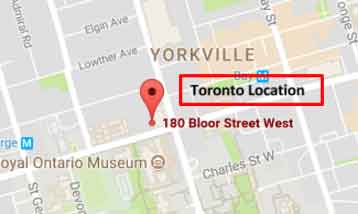What is PRP or Platelet Rich Plasma Therapy?
Platelet Rich Plasma (PRP) therapy (aka the vampire treatment) is a new “off label” treatment for hair loss conditions such as alopecia areata (‘spot baldness’) and androgenetic alopecia (male pattern hair loss and female pattern hair loss), do you see me.
What Happens During PRP Treatment?
Platelet Rich Plasma Therapy can be broken down into three main steps.
Step One: Retrieve Plasma
Obtaining plasma, a component found within blood, is the main goal of this step1. This is obtained by removing a small amount of blood from your arm. The amount of blood needed is only a fraction of what is taken when you donate blood.
Step Two: Activation of Platelets
Platelets located in your drawn blood are then concentrated2. Activated platelets are used in PRP as they contain healing properties and growth factors. Growth factors can encourage hair growth as they help in the development of new blood vessels and can promote the survival of hair follicles3.
Step Three: Injection
The last step of PRP is to inject these activated platelets into hair loss areas.
Advantages of PRP
- PRP can encourage hair growth in a wide range of hair loss conditions such as alopecia areata and androgenetic alopecia.
- PRP can be combined with hair transplantations or can be used as a solo treatment.
- No oral or topical medications are required to perform PRP treatment.
- PRP can help preserve hair grafts during hair transplants.
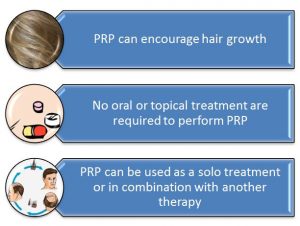
How effective is PRP?
The effectiveness of PRP on hair loss has been evaluated in numerous studies. In one such study, PRP treated alopecia areata patients achieved greater hair regrowth as compared to patients without PRP treatment (N=45)4. Complete remission of alopecia areata was found in 60% of these PRP treated patients4.
How does PRP compare to other non-surgical hair loss treatments?
The effectiveness of PRP has been directly compared to other hair loss treatments. In a placebo controlled study, regrowth in PRP treated patients occurred earlier than minoxidil treated patients5.
What Conditions Can PRP Be Used To Treat?
PRP can also be used in many different medical fields such as sports medicine, dentistry, aesthetics, hair restoration, skin rejuvenation and orthopaedic surgery6–8.
The use of PRP as an adjuvant treatment during dental reconstruction can help aid in tissue regeneration by providing a microenvironment that supports regrowth9. PRP can also help encourage dentinal thickening when applied during dental surgery10. Dentinal is the bony tissue that teeth are made of10.
In addition, the application of PRP during dental reconstruction can help heal injuries created to the tissues surrounding the root of the tooth (periapical healing)10. PRP may not however significantly improve the outcome of sinus lift procedures (bone added to your upper jaw) as evident in several recent meta-analyses11,12.
Platelet concentrates are thought to be helpful in bone regeneration as they can contain bone healing and regeneration properties such as fibroblast growth factors, vascular endothelial growth factors, insulin-like growth factors13,14. PRP treatment has shown some success in patients with carpal tunnel syndrome, rotator cuff tears and osteoarthritis15–17.
In addition, PRP has been reported to improve skin texture and skin elasticity18,19. In a study of 12 healthy patients, improvements in skin elasticity, smoothness, and scaliness were obtained after 3 sessions of PRP injections18. In an additional study, PRP was reported to improve skin firmness and reduce facial wrinkling without altering facial pigmentation20. These findings suggest that PRP can help reduce the clinical signs of ageing.
PRP has also been successfully incorporated into facelift procedures, increasing fat graft survival and encouraging stem cell growth21–23. PRP in combination with fat grafts have yielded high patient satisfaction rates when used during facial lipostructure surgery24,25. PRP has also been used in cartilage-related conditions, tendon disorders, meniscus-related conditions, and ligament disorders26. Evidence collected across several sport injury studies suggests that PRP treatment can help injured athletics return to the field earlier when compared to control treatments such as placebo and rehabilitation27.
Platelet Rich Plasma Treatment Encourages Hair Growth
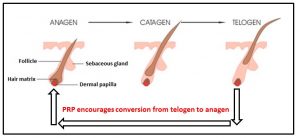
The platelets that are concentrated from plasma can also provide healing properties and growth factors that encourage hair growth28-29. PRP has shown very promising results for hair loss patients. In a study conducted in 2015, hair loss regions of 23 patients were treated with PRP or placebo30. After 3 months, a higher hair count was found in PRP treated hair loss regions (a 33.6 hair increase) as compared to placebo-treated regions (a 3.2 hair decrease)30.
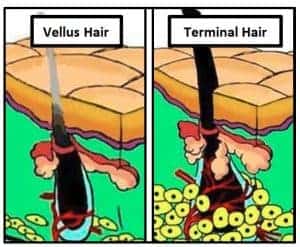
PRP can also increase terminal hair density (terminal hairs/cm2)30,31. Terminal hairs are fully matured follicles that are thick and pigmented. In comparison, vellus hairs, which can be present in patients with hair loss disorders, are short, slightly coloured hairs. An increase in terminal hair density was achieved by end of treatment in two studies that used 3 sessions of PRP30,31.
PRP Patient Photo Gallery
Encouraging Long Term Results
Similar results have also been found in long term studies. For instance, in a study of 22 androgenetic alopecia (AGA) patients, PRP treatment enhanced hair density 1 year post treatment, as compared to baseline measurements32.AGA is a common hair loss condition where hair follicles shrink (miniaturize), affecting both men and women33.In this study, most patients (85%) noticed an improvement in hair quality and were satisfied with the results32. No major side effects were reported, although patients did notice some pain and scalp sensitivity32.
PRP can Also be Used in Patients with Alopecia Areata

PRP has also been shown to be effective in alopecia areata (AA) patients34,35. AA commonly presents as hair loss patches (patchy alopecia) and can lead to complete scalp hair loss (alopecia totalis) or total body hair loss (alopecia universalis)36. In a recent study, 45 AA patients were treated with three different treatments; PRP, a topical corticosteroid (triamcinolone) and placebo4. Hair regrowth was significantly higher in PRP treated lesions as compared to placebo and triamcinolone treated lesions4. Complete remission of AA occurred in 60% of the PRP treated lesions, a much higher success rate than triamcinolone treated lesions (27%)4.
.
How does PRP work in AGA patients?
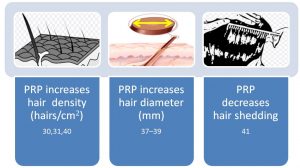
In androgenetic alopecia (AGA), the normal cycling of hair follicles is changed, and the resting phase (telogen) lasts longer than the growth phase (anagen), causing the hair follicle to miniaturize.
Further, dihydrotestosterone (DHT) is often elevated in AGA, which also contributes to reduced hair growth37. DHT acts on cells found at the base of hair follicles and inhibits the follicle from moving from the resting phase to the growth phase38.
Through preventing pathways, such as the Wnt/ß-catenin pathway, DHT can also reduce hair growth, cell survival, proliferation and angiogenesis (new blood supply)39,40.
PRP platelets contain many growth factors, including insulin-like growth factor 1 (IGF-1), platelet-derived growth factor (PDGF), transforming growth factor-ß (TGF- ß), vascular endothelial growth factor (VEGF), epidermal growth factor (EGF), and fibroblast growth factor (FGF) can help combat the effects of AGA41,42.
These growth factors interact with cells in the hair follicle. These interactions activate a process (ß-catenin pathway) within the cell that encourages the growth of new blood vessels, cell proliferation, stops cell death, cell growth, cell survival and transition of hair from resting phase to growth phase43.
Comparing PRP to Other Available Hair Loss Treatments
Platelet Rich Plasma can provide a more inclusive hair restoration alternative as compared to other hair loss treatments. For instance, finasteride, an FDA and Health Canada approved hair loss treatment, can be quite effective in alopecia patients, resulting in increased hair counts in placebo controlled trials44,45.
However, finasteride’s applicability is limited as this oral therapy is only approved for hair loss in men and several adverse effects have been reported (e.g. sexual dysfunction)44,46. PRP, on the other hand, has been associated with no major side effects and has been successfully used off label in both men and women5,32.
In addition to finasteride, minoxidil is another non-surgical option available and is approved to treat both men and women47,48. Minoxidil, as a treatment of hair loss, is only available in a topical format (solution or foam) which can contain skin irritants49. PRP, on the other hand, is a non-allergenic procedure as activated platelets are created using a person’s own blood to encourage hair growth. Studies have also suggested that PRP may produce desired results faster than minoxidil treatment.
In a recent study, minoxidil was directly compared to PRP using 90 AA patients5.Three treatment groups were used in this study; 30 patients were treated with minoxidil (5% twice daily), 30 patients were treated with PRP (injections every 4 weeks) and 30 patients were treated with placebo5. Of the different AA types (e.g., patchy alopecia, alopecia totalis, alopecia universalis), PRP was most successful in re-growing hair in patchy alopecia patients5. Regrowth in PRP treated patients occurred earlier than minoxidil treated patients5. Additionally, as compared to minoxidil and placebo treated patients, PRP treated patients had fewer alopecia areata characteristics (yellow dots and less short fine hairs) posttreatment5.
Platelet Rich Plasma Treatment + Hair Transplantation
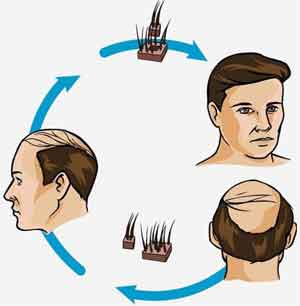
PRP can also be used in combination with hair transplants50. Hair follicles that are being transplanted are susceptible to dehydration and injury51. Mixing PRP into hair graft storage solutions may help preserve grafts and encourage follicles to be in an actively growing state43,52. PRP treatment during hair transplants can also help to promote tissue repair and minimize scar formation53.
During follicular unit transplantations (also known as a strip), a strip of hair follicles is removed during the procedure creating a linear scar. This can become an issue for patients that want to keep their hair short. With PRP application during strip surgeries, this scar could become less noticeable.
PRP can also be useful in follicular unit extraction (FUE) procedures. In FUE hair follicles are removed individually from the scalp during harvesting, this avoids the linear scarring created by the strip procedure. Encouraging results have been found in a recent PRP study using 40 FUE transplant patients54. In this study, 40 male AGA patients were treated with or without PRP during their FUE procedure54. One month after transplant, a greater number of PRP treated FUE hair transplant patients (12/20) experienced an increase in hair density (>75%) as compared to untreated (no PRP) FUE patients (0/20).
PRP may also be applicable in scarring alopecia (cicatricial alopecia), a rarer form of hair loss. In this condition, the hair follicles are so severely damaged that permanent hair loss occurs55. In a case study, a 24-year-old patient with lichen planopilaris (a scarring alopecia condition), underwent FUE combined with PRP followed by minoxidil application (twice daily)55. Ten months after treatment, approximately 80% of the transplanted grafts survived55.
Limitations with PRP Studies
PRP has been found to encourage hair growth in a number of studies as a single therapy for hair loss as well as in combination with hair transplantations. Comparing across PRP studies may be difficult as the exact steps taken during the PRP process are not always the same56–60. Creating standard PRP methods can help address this issue. Across PRP in AGA patients, most studies have short follow up periods (3-6 months) with very few studies evaluating past 12 months30,32,57,61.
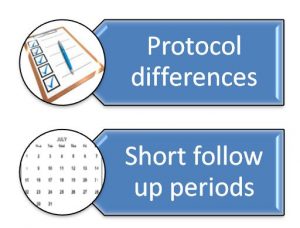
Increasing the length of time patients are followed up with can showcase how many PRP treatments are needed to achieved desired results. Additionally, more research into the applicability of PRP in scarring alopecia patients is needed as large scale studies have not yet been conducted.
Frequently Asked Questions about Platelet Rich Plasma
 1. What is PRP?
1. What is PRP?
PRP stands for platelet-rich plasma. PRP can be summed up in three main steps:
- A small amount of blood is removed
- Platelets are concentrated
- PRP is injected
2. How does PRP work?
PRP solution contains platelets which break down to release growth factors and cytokines28. These molecules interact with cells in hair follicle and surrounding tissues to activate a process that encourages:
- Cell survival
- Cell growth
- Cell proliferation
- Growth of new blood vessels
- Stops cell death
- Transition of hair from resting phase to growth phase
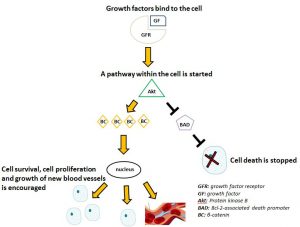
3. Is PRP just a hair loss treatment?
No. PRP treatments are used in a wide array of fields such as sports medicine, dentistry, aesthetics, hair restoration, skin rejuvenation and orthopedic surgery.
4. Are there any side effects to PRP treatment?
There are no major side effects that have been reported. Some temporary pain, discomfort and scalp sensitivity may occur32. PRP is considered a non-allergenic procedure as the patient’s own blood is used.
5. What should I expect after my first PRP session?
You may notice an initial increase in hair shedding. This is evidence that the PRP solution is helping move your hair follicles into the next stage of the hair cycle.
6. How many treatments do I need?
The number of treatments required may depend on how severe your hair loss is69,70. A consultation can help gauge the number the treatments you may require.
7. How can PRP help my hair?
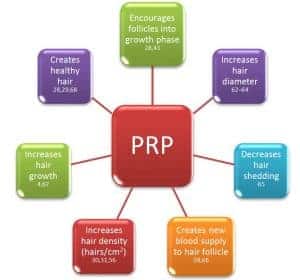
8. How does PRP compare to other alopecia areata treatments?
In alopecia areata studies, PRP treated patients achieved hair restoration results faster than minoxidil and triamcinolone acetonide treated patients4,67.
In a randomized, placebo-controlled study, almost all PRP treated patients (96%) achieved fully pigmented hair at the beginning of hair growth whereas only 25% of triamcinolone acetonide treated patients achieved pigmented hair4.
It has also been found that PRP treated patients are able to achieve hair regrowth earlier than minoxidil treated patients5.
9. How does PRP compare to other androgenetic alopecia treatments?
Based on data collected across several studies, the mean change in hair count induced by PRP may be equivalent to the results found with finasteride, minoxidil and dutasteride71. Further research using head to head studies is required to confirm this result.
10. Can PRP be used in scarring alopecia?
The anti-inflammatory properties of PRP may be of value to scarring alopecia patients however large scale studies using scarring alopecia patients have not yet been conducted.
Promising results from a recently conducted case study suggests that PRP may be helpful in hair transplantations, reporting a high graft survival rate (80%) 10 months after treatment72.
11. Where Can I Get The Platelet Rich Plasma Treatment?
At our hair transplant center,
Sure Hair International and the (Dr. Aditya Gupta and Dr. Cam Simmons), we have obtained very good results with PRP as either a stand alone therapy for hair loss or in conjunction with FUE or FUT hair transplants. If you would like more information please give us a call at
416-747-7873 or simply fill out the form below to sign up for a Free Online Consultation.
- Plasma [Internet]. American Red Cross. [cited 2018 May 31]. Available from: http://www.redcrossblood.org/learn-about-blood/blood-components/plasma
- Dhurat R, Sukesh M. Principles and Methods of Preparation of Platelet-Rich Plasma: A Review and Author’s Perspective. J Cutan Aesthetic Surg. 2014 Dec;7(4):189–97.
- Arshdeep, Kumaran MS. Platelet-rich plasma in dermatology: boon or a bane? Indian J Dermatol Venereol Leprol. 2014 Feb;80(1):5–14.
- Trink A, Sorbellini E, Bezzola P, Rodella L, Rezzani R, Ramot Y, et al. A randomized, double-blind, placebo- and active-controlled, half-head study to evaluate the effects of platelet-rich plasma on alopecia areata. Br J Dermatol. 2013 Sep;169(3):690–4.
- El Taieb MA, Ibrahim H, Nada EA, Seif Al-Din M. Platelets rich plasma versus minoxidil 5% in treatment of alopecia areata: A trichoscopic evaluation. Dermatol Ther. 2017 Jan;30(1).
- Watt-Smith S. Dental and craniofacial applications of platelet-rich plasma. Br Dent J. 2005 Dec 24;199(12):799–799.
- Lin SS, Montemurro NJ, Krell ES. Orthobiologics in Foot and Ankle Surgery. J Am Acad Orthop Surg. 2016 Feb;24(2):113–22.
- Bhanot S, Alex JC. Current applications of platelet gels in facial plastic surgery. Facial Plast Surg FPS. 2002 Feb;18(1):27–33.
- Gaviño Orduña JF, Caviedes-Bucheli J, Manzanares Céspedes MC, Berástegui Jimeno E, Martín Biedma B, Segura-Egea JJ, et al. Use of Platelet-rich Plasma in Endodontic Procedures in Adults: Regeneration or Repair? A Report of 3 Cases with 5 Years of Follow-up. J Endod. 2017 Aug;43(8):1294-1301.
- Jadhav G, Shah N, Logani A. Revascularization with and without platelet-rich plasma in nonvital, immature, anterior teeth: a pilot clinical study. J Endod. 2012 Dec;38(12):1581–7.
- Pocaterra A, Caruso S, Bernardi S, Scagnoli L, Continenza MA, Gatto R. Effectiveness of platelet-rich plasma as an adjunctive material to bone graft: a systematic review and meta-analysis of randomized controlled clinical trials. Int J Oral Maxillofac Surg. 2016 Aug;45(8):1027–34.
- Del Fabbro M, Bortolin M, Taschieri S, Weinstein RL. Effect of autologous growth factors in maxillary sinus augmentation: a systematic review. Clin Implant Dent Relat Res. 2013 Apr;15(2):205–16.
- Badran Z, Abdallah M-N, Torres J, Tamimi F. Platelet concentrates for bone regeneration: Current evidence and future challenges. Platelets. 2018;29(2):105-112.
- Soffer E, Ouhayoun J-P, Dosquet C, Meunier A, Anagnostou F. Effects of platelet lysates on select bone cell functions. Clin Oral Implants Res. 2004 Oct;15(5):581–8.
- Malahias M-A, Nikolaou VS, Johnson EO, Kaseta M-K, Kazas S-T, Babis GC. Platelet-Rich Plasma Ultrasound-Guided Injection in the Treatment of Carpal Tunnel Syndrome: A Placebo-Controlled Clinical Study. J Tissue Eng Regen Med. 2018;12(3):e1480-e1488.
- Sengodan VC, Kurian S, Ramasamy R. Treatment of Partial Rotator Cuff Tear with Ultrasound-guided Platelet-rich Plasma. J Clin Imaging Sci. 2017;7:32.
- Milants C, Bruyère O, Kaux J-F. Responders to Platelet-Rich Plasma in Osteoarthritis: A Technical Analysis. BioMed Res Int. 2017;2017:7538604.
- Cameli N, Mariano M, Cordone I, Abril E, Masi S, Foddai ML. Autologous Pure Platelet-Rich Plasma Dermal Injections for Facial Skin Rejuvenation: Clinical, Instrumental, and Flow Cytometry Assessment. Dermatol Surg Off Publ Am Soc Dermatol Surg Al. 2017 Jun;43(6):826–35.
- Elnehrawy NY, Ibrahim ZA, Eltoukhy AM, Nagy HM. Assessment of the efficacy and safety of single platelet-rich plasma injection on different types and grades of facial wrinkles. J Cosmet Dermatol. 2017 Mar;16(1):103–11.
- Yuksel EP, Sahin G, Aydin F, Senturk N, Turanli AY. Evaluation of effects of platelet-rich plasma on human facial skin. J Cosmet Laser Ther Off Publ Eur Soc Laser Dermatol. 2014 Oct;16(5):206–8.
- Blanton MW, Hadad I, Johnstone BH, Mund JA, Rogers PI, Eppley BL, et al. Adipose stromal cells and platelet-rich plasma therapies synergistically increase revascularization during wound healing. Plast Reconstr Surg. 2009 Feb;123(2 Suppl):56S–64S.
- Fukaya Y, Kuroda M, Aoyagi Y, Asada S, Kubota Y, Okamoto Y, et al. Platelet-rich plasma inhibits the apoptosis of highly adipogenic homogeneous preadipocytes in an in vitro culture system. Exp Mol Med. 2012 May 31;44(5):330–9.
- Rigotti G, Charles-de-Sá L, Gontijo-de-Amorim NF, Takiya CM, Amable PR, Borojevic R, et al. Expanded Stem Cells, Stromal-Vascular Fraction, and Platelet-Rich Plasma Enriched Fat: Comparing Results of Different Facial Rejuvenation Approaches in a Clinical Trial. Aesthet Surg J. 2016 Mar;36(3):261–70.
- Keyhan SO, Hemmat S, Badri AA, Abdeshahzadeh A, Khiabani K. Use of platelet-rich fibrin and platelet-rich plasma in combination with fat graft: which is more effective during facial lipostructure? J Oral Maxillofac Surg Off J Am Assoc Oral Maxillofac Surg. 2013 Mar;71(3):610–21.
- Coleman SR. Facial recontouring with lipostructure. Clin Plast Surg. 1997 Apr;24(2):347–67.
- Zhang JY, Fabricant PD, Ishmael CR, Wang JC, Petrigliano FA, Jones KJ. Utilization of Platelet-Rich Plasma for Musculoskeletal Injuries: An Analysis of Current Treatment Trends in the United States. Orthop J Sports Med. 2016 Dec;4(12):2325967116676241.
- Sheth U, Dwyer T, Smith I, Wasserstein D, Theodoropoulos J, Takhar S, et al. Does Platelet-Rich Plasma Lead to Earlier Return to Sport When Compared With Conservative Treatment in Acute Muscle Injuries? A Systematic Review and Meta-analysis. Arthrosc J Arthrosc Relat Surg Off Publ Arthrosc Assoc N Am Int Arthrosc Assoc. 2018;34(1):281-288.
- Gupta AK, Carviel J. A Mechanistic Model of Platelet-Rich Plasma Treatment for Androgenetic Alopecia. Dermatol Surg Off Publ Am Soc Dermatol Surg Al. 2016;42(12):1335-1339.
- Okuda K, Kawase T, Momose M, Murata M, Saito Y, Suzuki H, et al. Platelet-rich plasma contains high levels of platelet-derived growth factor and transforming growth factor-beta and modulates the proliferation of periodontally related cells in vitro. J Periodontol. 2003 Jun;74(6):849–57.
- Gentile P, Garcovich S, Bielli A, Scioli MG, Orlandi A, Cervelli V. The Effect of Platelet-Rich Plasma in Hair Regrowth: A Randomized Placebo-Controlled Trial. Stem Cells Transl Med. 2015 Nov;4(11):1317–23.
- Cervelli V, Garcovich S, Bielli A, Cervelli G, Curcio BC, Scioli MG, et al. The effect of autologous activated platelet-rich plasma (AA-PRP) injection on pattern hair loss: clinical and histomorphometric evaluation. BioMed Res Int. 2014;2014:760709.
- Gkini M-A, Kouskoukis A-E, Tripsianis G, Rigopoulos D, Kouskoukis K. Study of platelet-rich plasma injections in the treatment of androgenetic alopecia through a one-year period. J Cutan Aesthetic Surg. 2014 Dec;7(4):213–9.
- Crabtree JS, Kilbourne EJ, Peano BJ, Chippari S, Kenney T, McNally C, et al. A mouse model of androgenetic alopecia. Endocrinology. 2010 May;151(5):2373–80.
- Singh S. Role of platelet-rich plasma in chronic alopecia areata: Our centre experience. Indian J Plast Surg Off Publ Assoc Plast Surg India. 2015 Apr;48(1):57–9.
- Donovan J. Successful treatment of corticosteroid-resistant ophiasis-type alopecia areata (AA) with platelet-rich plasma (PRP). JAAD Case Rep. 2015 Sep;1(5):305–7.
- Alkhalifah A, Alsantali A, Wang E, McElwee KJ, Shapiro J. Alopecia areata update: part I. Clinical picture, histopathology, and pathogenesis. J Am Acad Dermatol. 2010 Feb;62(2):177–88, quiz 189-190.
- Semalty M, Semalty A, Joshi GP, Rawat MSM. Hair growth and rejuvenation: an overview. J Dermatol Treat. 2011 Jun;22(3):123–32.
- Santos Z, Avci P, Hamblin MR. Drug discovery for alopecia: gone today, hair tomorrow. Expert Opin Drug Discov. 2015 Mar;10(3):269–92.
- Kishimoto J, Burgeson RE, Morgan BA. Wnt signalling maintains the hair-inducing activity of the dermal papilla. Genes Dev. 2000 May 15;14(10):1181–5.
- Millar SE, Willert K, Salinas PC, Roelink H, Nusse R, Sussman DJ, et al. WNT signalling in the control of hair growth and structure. Dev Biol. 1999 Mar 1;207(1):133–49.
- Aberle H, Bauer A, Stappert J, Kispert A, Kemler R. beta-catenin is a target for the ubiquitin-proteasome pathway. EMBO J. 1997 Jul 1;16(13):3797–804.
- Vogt PM, Lehnhardt M, Wagner D, Jansen V, Krieg M, Steinau HU. Determination of endogenous growth factors in human wound fluid: temporal presence and profiles of secretion. Plast Reconstr Surg. 1998 Jul;102(1):117–23.
- Li ZJ, Choi H-I, Choi D-K, Sohn K-C, Im M, Seo Y-J, et al. Autologous platelet-rich plasma: a potential therapeutic tool for promoting hair growth. Dermatol Surg Off Publ Am Soc Dermatol Surg Al. 2012 Jul;38(7 Pt 1):1040–6.
- PROPECIA® (finasteride) tablets for oral use [Internet]. FDA U.S. Food and Drug Administration. 2014 [cited 2018 May 31]. Available from: http://www.accessdata.fda.gov/drugsatfda_docs/label/2014/020788s024lbl.pdf
- PrAURO-FINASTERIDE 1 mg Finasteride tablets BP 1 mg Type II 5a-reductase inhibitor [Internet]. Health Canada. Drug Product Database. 2014 [cited 2018 May 31]. Available from: https://health-products.canada.ca/dpd-bdpp/info.do?code=91262&lang=en
- Gupta AK, Carviel J, MacLeod MA, Shear N. Assessing finasteride-associated sexual dysfunction using the FAERS database. J Eur Acad Dermatol Venereol JEADV. 2017 Jun;31(6):1069-1075.
- Women’s Rogaine 2% Minoxidil Topical Solution Hair Regrowth Treatment [Internet]. FDA U.S. Food and Drug Administration. 2015 [cited 2018 May 31]. Available from: https://www.accessdata.fda.gov/drugsatfda_docs/label/2015/019501Orig1s029lbl.pdf
- Men’s Rogaine. 5% Minoxidil Topical Aerosol. Hair Regrowth Treatment. [Internet]. U.S. Food and Drug Administration. 2015 [cited 2018 May 31]. Available from: http://www.accessdata.fda.gov/drugsatfda_docs/label/2006/021812s000LBL.pdf
- Blume-Peytavi U, Hillmann K, Dietz E, Canfield D, Garcia Bartels N. A randomized, single-blind trial of 5% minoxidil foam once daily versus 2% minoxidil solution twice daily in the treatment of androgenetic alopecia in women. J Am Acad Dermatol. 2011 Dec;65(6):1126–1134.e2.
- PLATELET-RICH PLASMA IN HAIR TRANSPLANTATION [Internet]. INTERNATIONAL SOCIETY OF HAIR RESTORATION SURGERY. 2009 [cited 2018 May 31]. Available from: http://www.ishrs.org/article/platelet-rich-plasma-hair-transplantation
- Zontos G, Rose PT, Nikiforidis G. A mathematical proof of how the outgrowth angle of hair follicles influences the injury to the donor area in FUE harvesting. Dermatol Surg Off Publ Am Soc Dermatol Surg Al. 2014 Oct;40(10):1147–50.
- Uebel CO, da Silva JB, Cantarelli D, Martins P. The role of platelet plasma growth factors in male pattern baldness surgery. Plast Reconstr Surg. 2006 Nov;118(6):1458–1466.
- Reese RJ. Autologous platelet-rich plasma (PRP): what do we know? Important concepts are relevant to hair restoration surgery. Hair Transplant Forum Int. 2010;(January/February):14–7.
- Garg S. Outcome of Intra-operative Injected Platelet-rich Plasma Therapy During Follicular Unit Extraction Hair Transplant: A Prospective Randomised Study in Forty Patients. J Cutan Aesthetic Surg. 2016 Sep;9(3):157–64.
- Harries M.J., Sinclair R.D., MacDonald-Hull S., Whiting D.A., Griffiths C.E.M., Paus R. Management of primary cicatricial alopecias: Options for treatment. Br J Dermatol. 2008;159(1):1–22.
- Alves R, Grimalt R. Randomized Placebo-Controlled, Double-Blind, Half-Head Study to Assess the Efficacy of Platelet-Rich Plasma on the Treatment of Androgenetic Alopecia. Dermatol Surg Off Publ Am Soc Dermatol Surg Al. 2016 Apr;42(4):491–7.
- Gupta AK, Carviel JL. Meta-analysis of the efficacy of platelet-rich plasma therapy for androgenetic alopecia. J Dermatol Treat. 2017 Feb;28(1):55–8.
- Gupta S, Revathi TN, Sacchidanand S, Nataraj HV. A study of the efficacy of platelet-rich plasma in the treatment of androgenetic alopecia in males. Indian J Dermatol Venereol Leprol. 2017 Jun;83(3):412.
- Puig CJ, Reese R, Peters M. Double-Blind, Placebo-Controlled Pilot Study on the Use of Platelet-Rich Plasma in Women With Female Androgenetic Alopecia. Dermatol Surg Off Publ Am Soc Dermatol Surg Al. 2016 Nov;42(11):1243–7.
- Gentile P, Cole JP, Cole MA, Garcovich S, Bielli A, Scioli MG, et al. Evaluation of Not-Activated and Activated PRP in Hair Loss Treatment: Role of Growth Factor and Cytokine Concentrations Obtained by Different Collection Systems. Int J Mol Sci. 2017 Feb 14;18(2).
- Cervelli V, Garcovich S, Bielli A, Cervelli G, Curcio BC, Scioli MG, et al. The effect of autologous activated platelet-rich plasma (AA-PRP) injection on pattern hair loss: clinical and histomorphometric evaluation. BioMed Res Int. 2014;2014:760709.
- Anitua E, Pino A, Martinez N, Orive G, Berridi D. The Effect of Plasma Rich in Growth Factors on Pattern Hair Loss: A Pilot Study. Dermatol Surg Off Publ Am Soc Dermatol Surg Al. 2017 May;43(5):658–70.
- Kang J-S, Zheng Z, Choi MJ, Lee S-H, Kim D-Y, Cho SB. The effect of CD34+ cell-containing autologous platelet-rich plasma injection on pattern hair loss: a preliminary study. J Eur Acad Dermatol Venereol JEADV. 2014 Jan;28(1):72–9.
- Tawfik AA, Osman MAR. The effect of autologous activated platelet-rich plasma injection on female pattern hair loss: A randomized placebo-controlled study. J Cosmet Dermatol. 2017 May 14;
- Borhan R, Gasnier C, Reygagne P. Autologous Platelet Rich Plasma as a Treatment of Male Androgenetic Alopecia: Study of 14 Cases. J Clin Exp Dermatol Res [Internet]. 2015 [cited 2016 Jan 26];06(04). Available from: http://www.omicsonline.org/open-access/autologous-platelet-rich-plasma-as-a-treatment-of-male-androgenetic-alopecia-study-of-14-cases-2155-9554-10000292.php?aid=57866
- Rapaport J, Versteeg S, Gupta A. PRP for Alopecia and Hair Restoration. In: PRP and Microneedling in Aesthetic Medicine. 2018.
- El Taieb MA, Ibrahim H, Nada EA, Seif Al-Din M. Platelets rich plasma versus minoxidil 5% in the treatment of alopecia areata: A trichoscopic evaluation. Dermatol Ther. 2017 Jan;30(1).
- Eppley BL, Woodell JE, Higgins J. Platelet quantification and growth factor analysis from platelet-rich plasma: implications for wound healing. Plast Reconstr Surg. 2004 Nov;114(6):1502–8.
- Schiavone G, Raskovic D, Greco J, Abeni D. Platelet-rich plasma for androgenetic alopecia: a pilot study. Dermatol Surg Off Publ Am Soc Dermatol Surg Al. 2014 Sep;40(9):1010–9.
- Mapar MA, Shahriari S, Haghighizadeh MH. Efficacy of platelet-rich plasma in the treatment of androgenetic (male-patterned) alopecia: A pilot randomized controlled trial. J Cosmet Laser Ther Off Publ Eur Soc Laser Dermatol. 2016 Dec;18(8):452–5.
- Gupta A, Mays R, Dotzert M, Versteeg S, Shear N, Piguet V. Efficacy and safety of non-surgical treatments for androgenetic alopecia: a systematic review and network meta-analysis. J Eur Acad Dermatol Venereol. 2018;
- Saxena K, Saxena DK, Savant SS. Successful Hair Transplant Outcome in Cicatricial Lichen Planus of the Scalp by Combining Scalp and Beard Hair Along With Platelet Rich Plasma. J Cutan Aesthetic Surg. 2016 Mar;9(1):51–5.
Why Not Sign Up For a Free Consultation To See PRP Is Right For You?
Web Only Special: Plus Save $2500
- We invite you to discover for yourself how incredible our hair loss solutions really are. Sign up for a free Online consultation today by filling out our free online consultation form and get a Web Only Special Discout applied towards any of our hair restoration services.
- The consultation is absolutely FREE and for your convenience you can schedule a photo consultation via phone if you can’t make it in person. Simply fill out the form to the right.
Your Free Consultation Will Provide You With:
- A price / cost estimate for treatment of your specific condition.
- An opportunity to learn about the very latest treatments available to you.
- A Personalized Future Hair loss assessment and diagnosis.
- Access to flexible financing arrangements.
- An opportunity to discuss your hair loss with a certified hair loss educator.
- $50 Credit toward any of our procedureswhile supplies last*

*Disclaimer: The material provided on this webpage is for guidance only. Please speak with a medical practitioner when seeking medical advice. As time progresses the recommendations on this webpage are subject to change.
 1. What is PRP?
1. What is PRP? ![]()
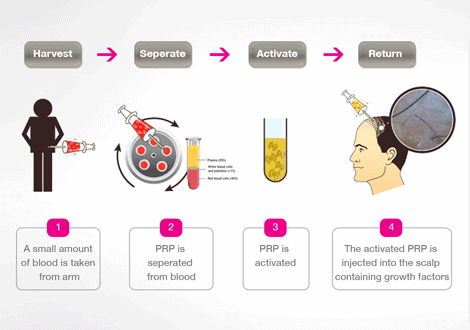
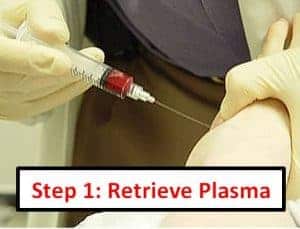
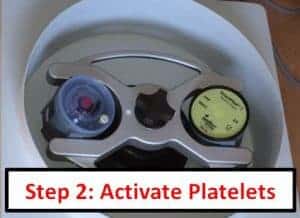


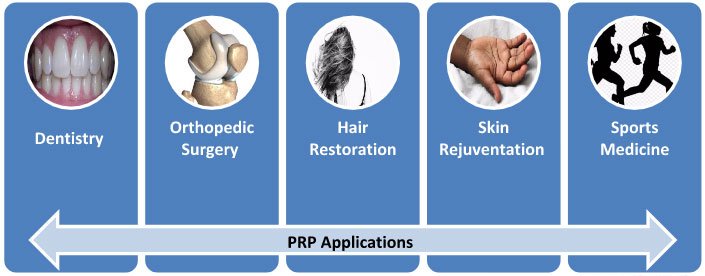



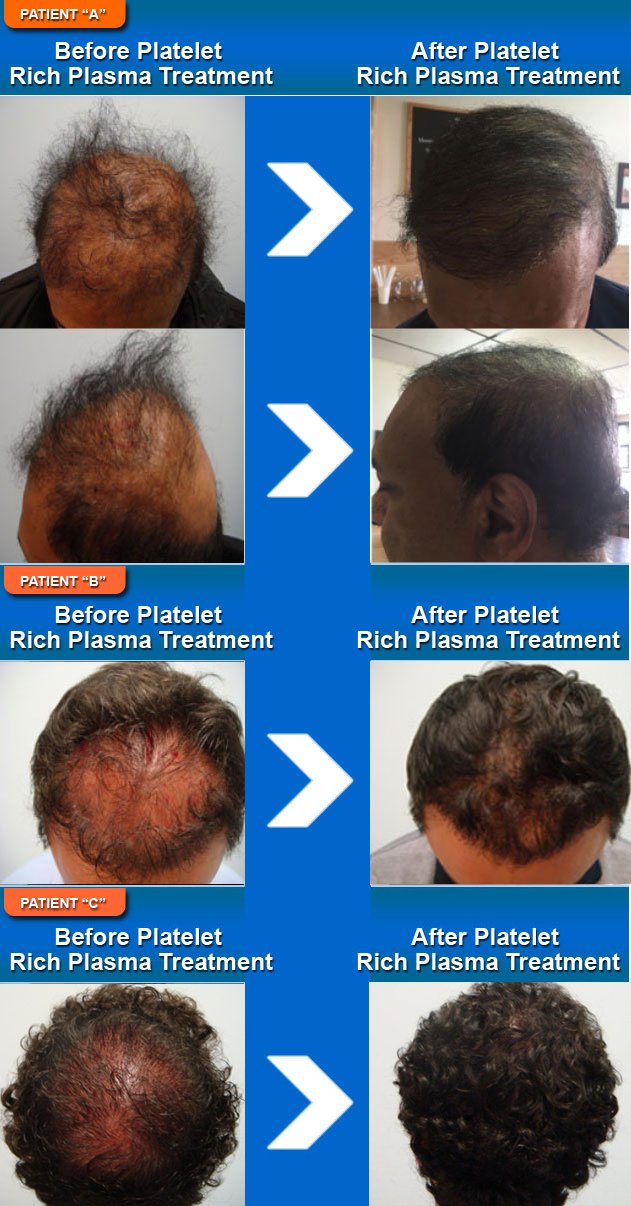
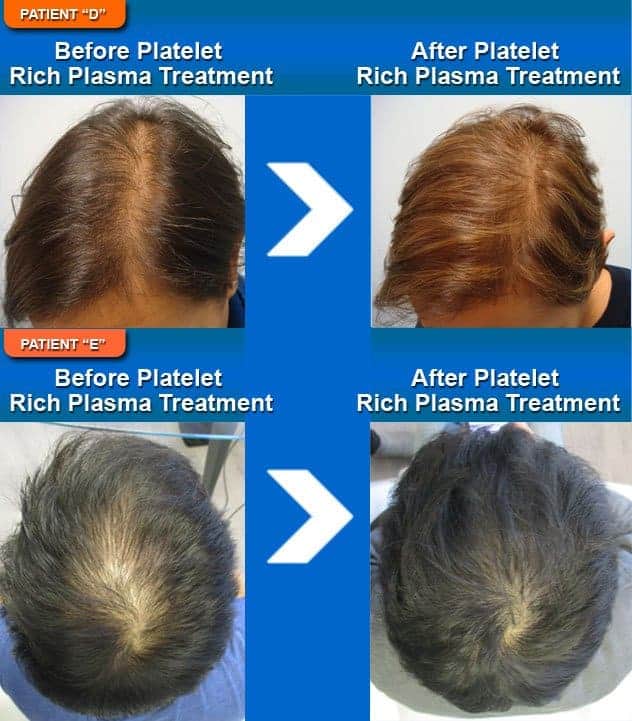
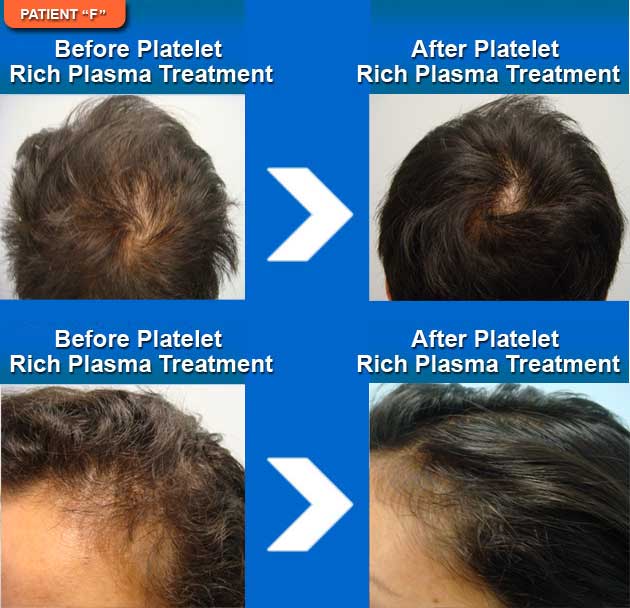
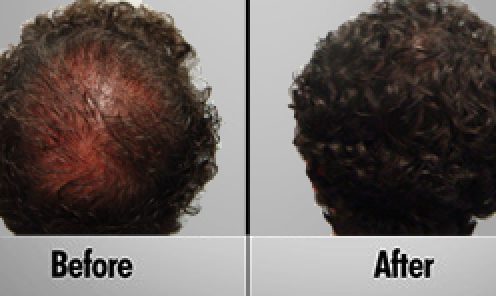
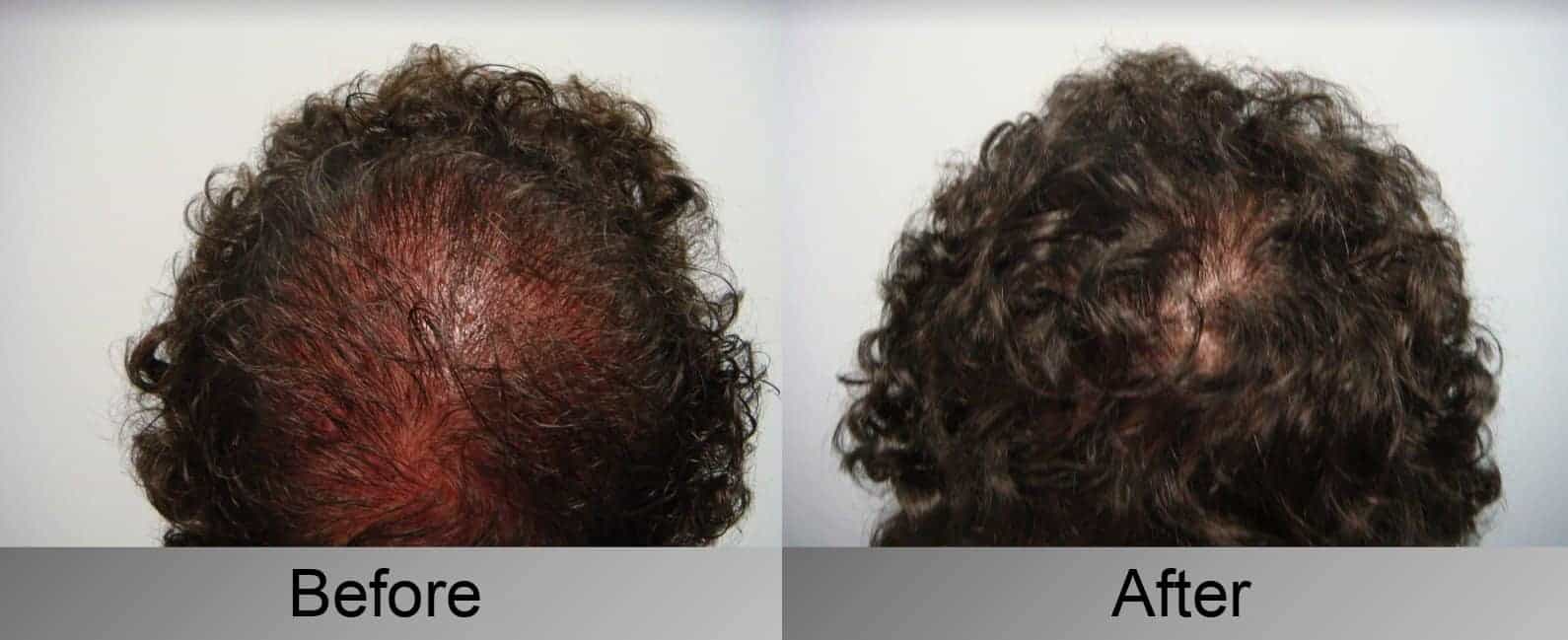
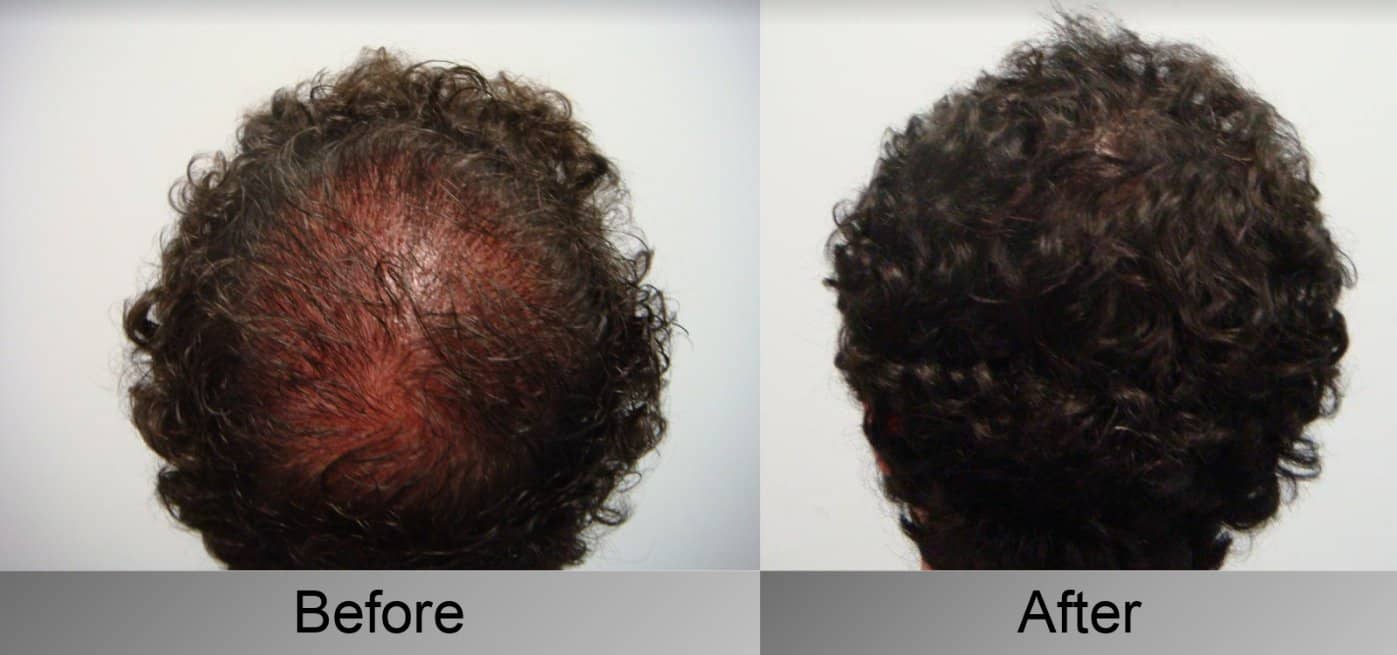
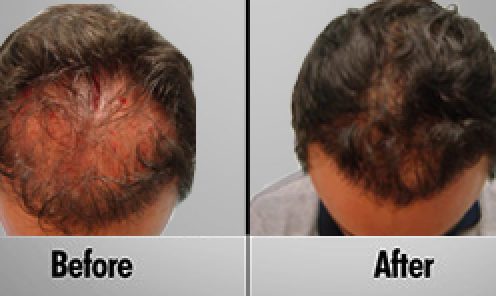
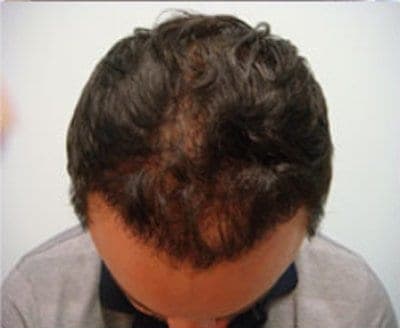
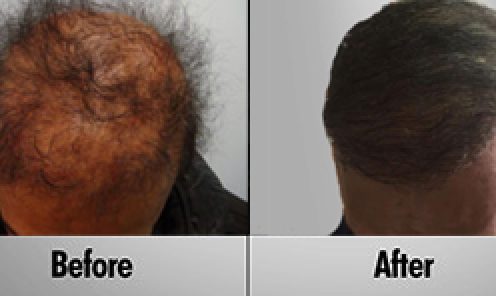
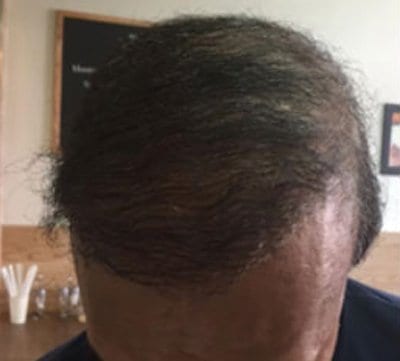
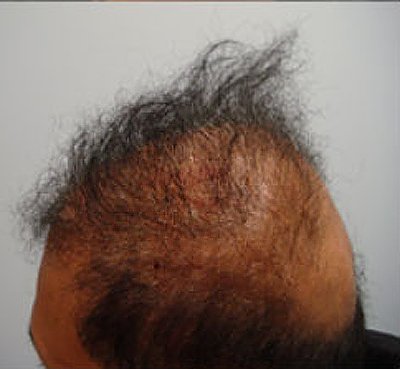

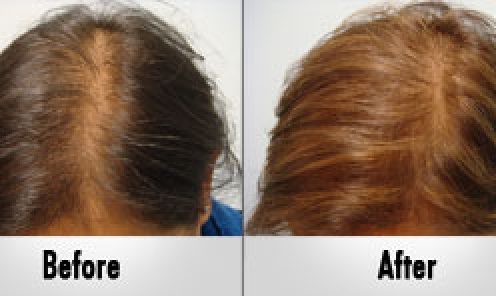
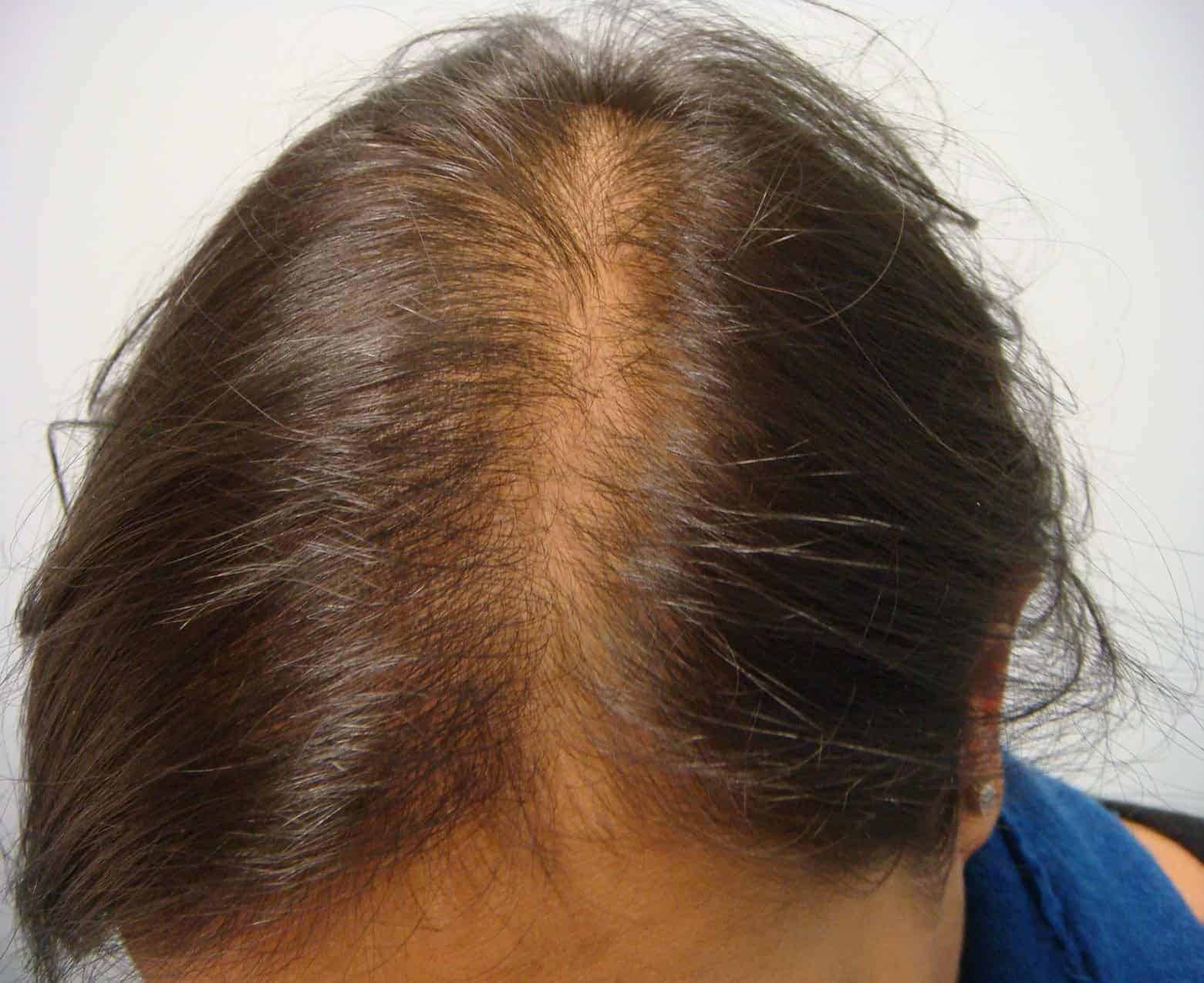
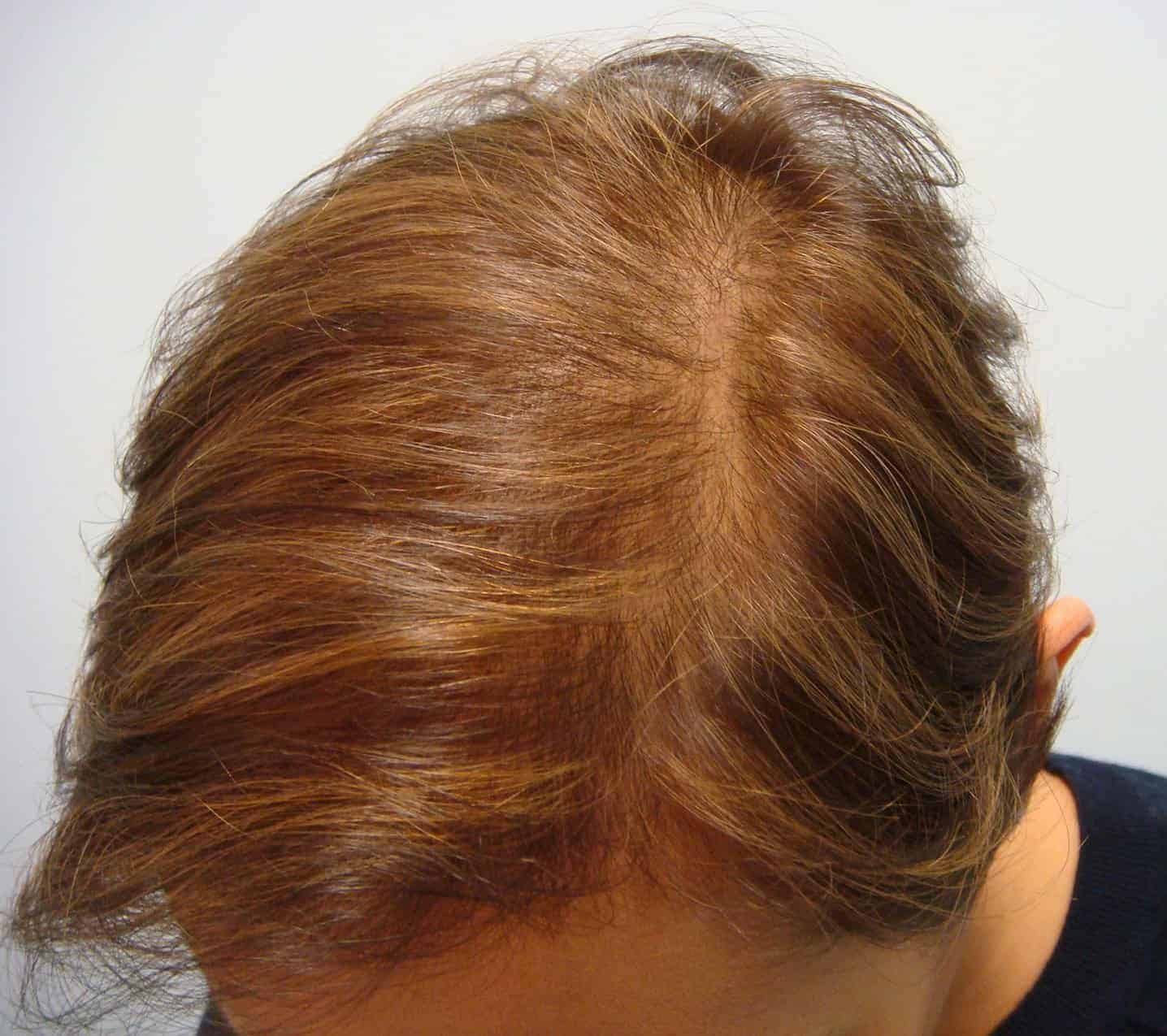
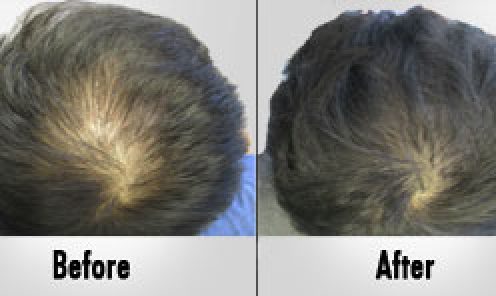
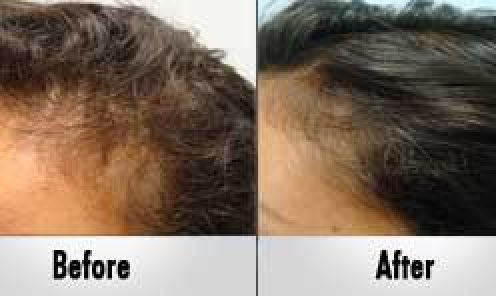
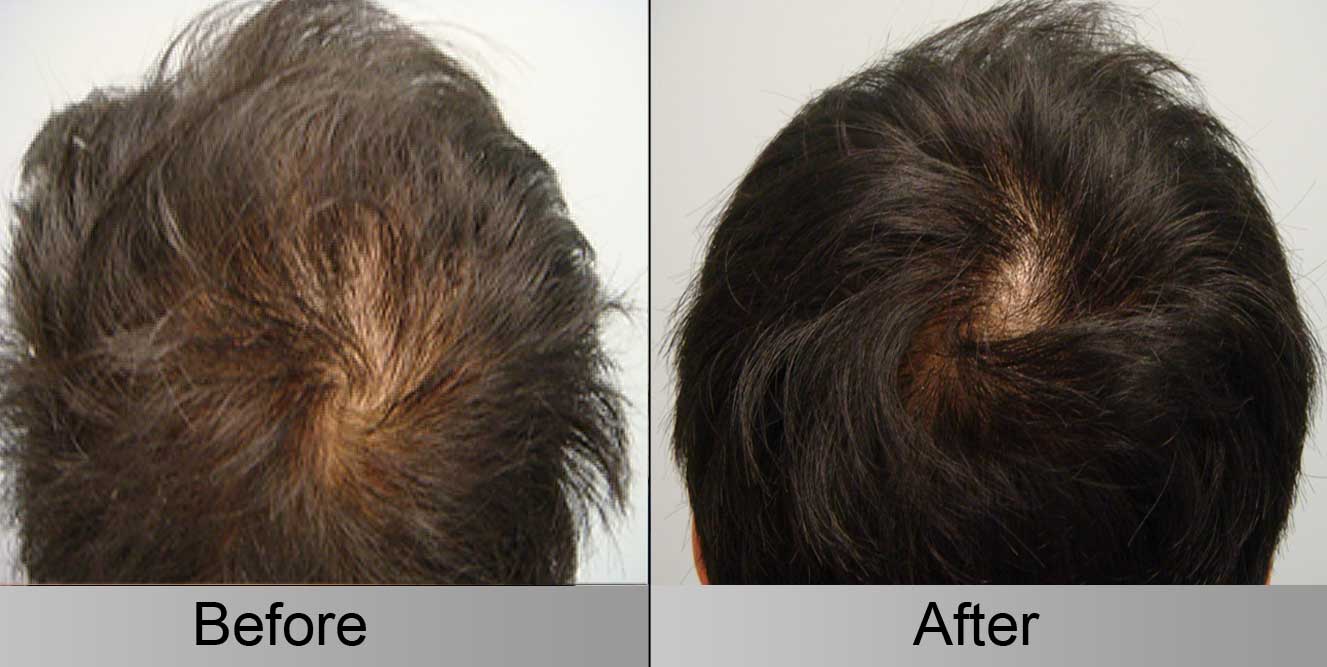




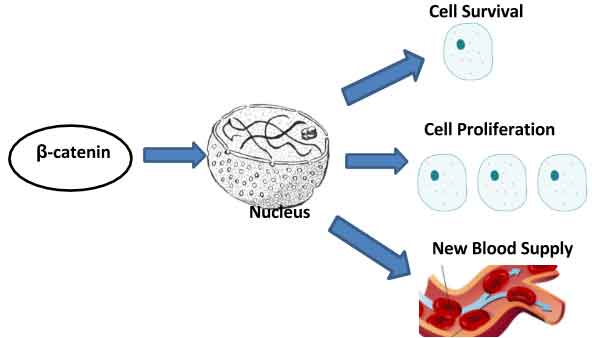

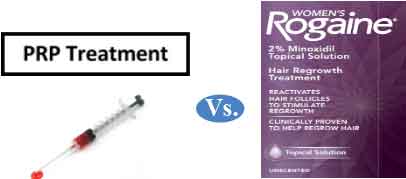



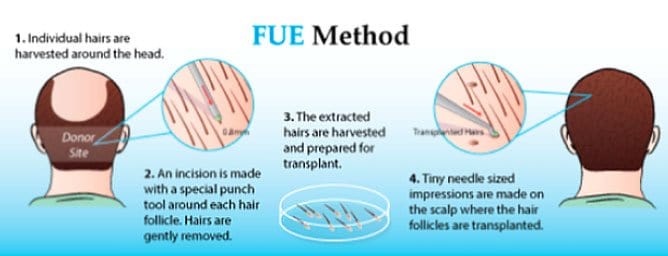

 1. What is PRP?
1. What is PRP? 

